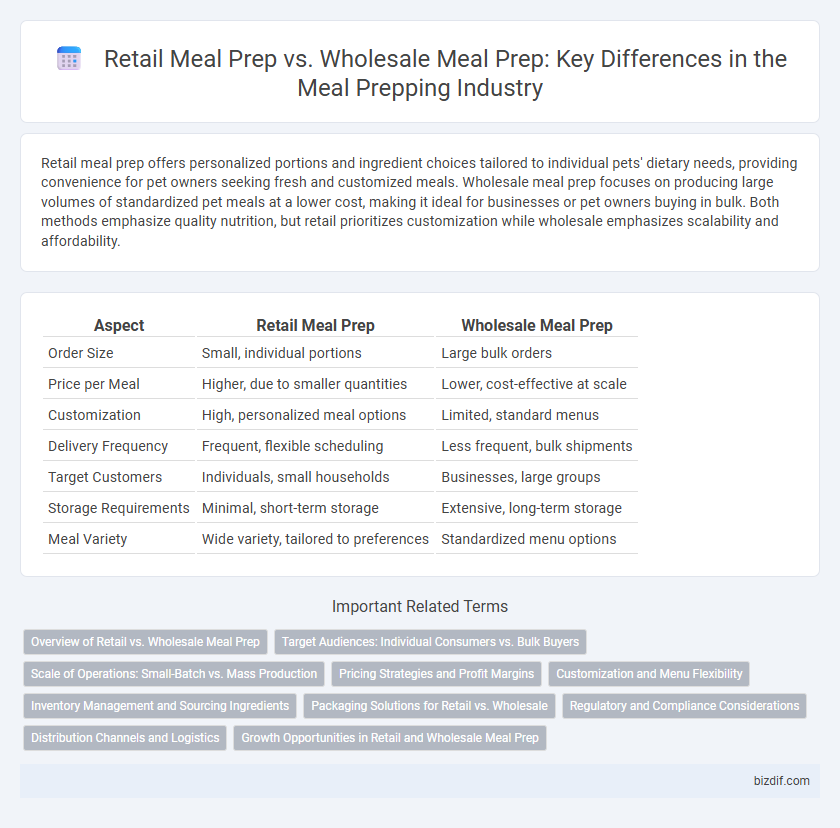Retail meal prep offers personalized portions and ingredient choices tailored to individual pets' dietary needs, providing convenience for pet owners seeking fresh and customized meals. Wholesale meal prep focuses on producing large volumes of standardized pet meals at a lower cost, making it ideal for businesses or pet owners buying in bulk. Both methods emphasize quality nutrition, but retail prioritizes customization while wholesale emphasizes scalability and affordability.
Table of Comparison
| Aspect | Retail Meal Prep | Wholesale Meal Prep |
|---|---|---|
| Order Size | Small, individual portions | Large bulk orders |
| Price per Meal | Higher, due to smaller quantities | Lower, cost-effective at scale |
| Customization | High, personalized meal options | Limited, standard menus |
| Delivery Frequency | Frequent, flexible scheduling | Less frequent, bulk shipments |
| Target Customers | Individuals, small households | Businesses, large groups |
| Storage Requirements | Minimal, short-term storage | Extensive, long-term storage |
| Meal Variety | Wide variety, tailored to preferences | Standardized menu options |
Overview of Retail vs. Wholesale Meal Prep
Retail meal prep targets individual consumers with single or small portions, offering convenience and variety through ready-to-eat meals available in supermarkets or online. Wholesale meal prep caters to large clients like restaurants, cafeterias, or events, providing bulk quantities at lower prices with streamlined production processes. The key differences lie in packaging sizes, pricing strategies, and distribution channels optimized for consumer needs versus organizational demands.
Target Audiences: Individual Consumers vs. Bulk Buyers
Retail meal prep services primarily cater to individual consumers seeking convenience, portion control, and personalized dietary options for daily meals. Wholesale meal prep targets bulk buyers such as gyms, corporate cafeterias, and catering companies, emphasizing large order volumes, cost efficiency, and standardized menu offerings. Understanding the distinct needs of these audiences helps optimize product packaging, pricing strategies, and menu customization.
Scale of Operations: Small-Batch vs. Mass Production
Retail meal prep typically involves small-batch production tailored to individual customer orders, allowing for customized meals and faster turnaround times. Wholesale meal prep operates on a mass production scale, focusing on large quantities to supply businesses, institutions, or food service providers efficiently. The scale of operations influences packaging, ingredient sourcing, and menu variety, with retail emphasizing personalization and wholesale prioritizing volume and cost-efficiency.
Pricing Strategies and Profit Margins
Retail meal prep pricing strategies typically involve higher per-unit costs due to smaller batch sizes and individualized packaging, which allows for premium pricing and improved profit margins per meal. Wholesale meal prep focuses on bulk production with economies of scale, significantly lowering the cost per unit but often requiring competitive pricing to attract large buyers, resulting in tighter profit margins. Effective wholesale strategies balance volume discounts with streamlined operations to maintain profitability, while retail strategies capitalize on convenience and customization to enhance customer value and margin.
Customization and Menu Flexibility
Retail meal prep services offer high customization and menu flexibility, allowing customers to select meals based on dietary preferences, portion sizes, and ingredient choices tailored to individual needs. Wholesale meal prep emphasizes bulk production with standardized menus to maximize efficiency and cost-effectiveness, limiting customization options for end consumers. This contrast highlights retail meal prep as ideal for personalized nutrition, while wholesale suits large organizations seeking uniform meal solutions.
Inventory Management and Sourcing Ingredients
Retail meal prep requires meticulous inventory management to cater to diverse consumer preferences, often sourcing ingredients in smaller, high-quality batches to maintain freshness and variety. Wholesale meal prep focuses on bulk ingredient procurement, optimizing cost-efficiency and supply chain stability through long-term contracts and volume discounts. Effective sourcing in wholesale models leverages supplier relationships and demand forecasting to minimize waste and ensure consistent ingredient availability.
Packaging Solutions for Retail vs. Wholesale
Retail meal prep packaging solutions prioritize convenience, portion control, and eye-catching design to attract individual consumers and ensure freshness for short-term storage. Wholesale meal prep packaging focuses on cost-efficiency, durability, and stackability to facilitate large-volume transportation and extended shelf life in bulk distribution. Both packaging types optimize material usage and sealing technology but differ significantly in size, labeling, and branding to meet distinct market demands.
Regulatory and Compliance Considerations
Retail meal prep operations must adhere to strict local health department regulations, including individual meal labeling, ingredient disclosure, and portion control to meet consumer safety standards. Wholesale meal prep providers face compliance challenges related to larger-scale food safety protocols, such as Hazard Analysis Critical Control Points (HACCP) certifications and compliance with Food and Drug Administration (FDA) regulations for mass distribution. Both models require regular inspections and documentation to ensure adherence to Good Manufacturing Practices (GMP) and prevent contamination risks in the supply chain.
Distribution Channels and Logistics
Retail meal prep typically involves smaller, frequent deliveries to individual consumers or local stores, emphasizing flexible distribution channels and last-mile logistics to ensure freshness and timely delivery. Wholesale meal prep operates on bulk production with streamlined logistics, leveraging centralized distribution centers and efficient supply chain management to supply restaurants, cafeterias, or large retailers. Optimizing transportation routes and cold storage solutions is crucial in both models, but wholesale demands higher capacity handling and coordination across multiple distribution points.
Growth Opportunities in Retail and Wholesale Meal Prep
Growth opportunities in retail meal prep are driven by increasing consumer demand for convenience, personalized meal options, and health-conscious choices, leading to expanded product varieties and targeted marketing strategies. Wholesale meal prep growth is fueled by partnerships with gyms, corporate offices, and healthcare facilities, enabling bulk production efficiencies and consistent volume sales. Both sectors benefit from technological advancements in supply chain management and online ordering platforms that streamline operations and enhance customer reach.
Retail meal prep vs wholesale meal prep Infographic

 bizdif.com
bizdif.com